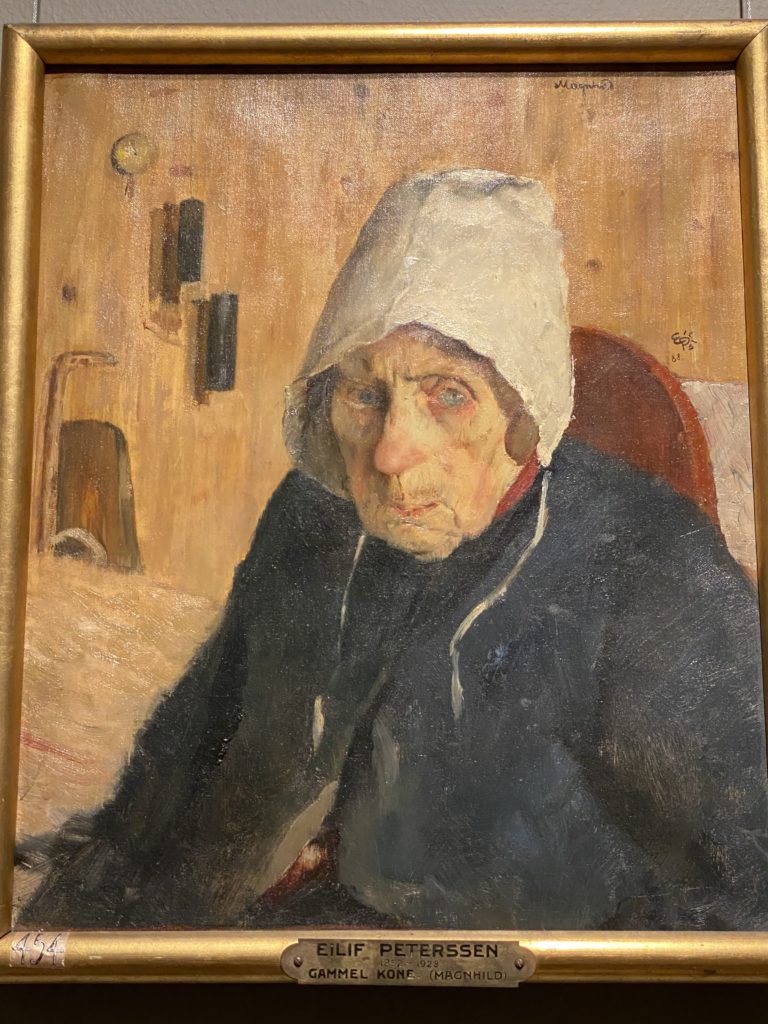
By Patrick Hunt –
Sometimes there are portraits that are so gripping you cannot move on for a long time. As a prelude I spend time in Bergen, Norway, every year and my visits always include the Kode Bergen Art Museum, especially the collection in the four white buildings along the city lake Lille Lungegardsvannet. The collection is particularly strong in early Norwegian Romantic artists like Johann Christian Dahl (1788-1857) as well as the uniquely Norwegian modern artist Nikolai Astrup (1880-1928), both of whom deserve immense attention not offered here in this brief overview.
But this summer while I again enjoyed the superb Bergen collection, I found myself riveted by a portrait that demanded an intense viewing my eyes and mind could not possibly escape even though I had seen it quite a few times before and had passed by it multiple times. It remains a mystery why one can give a painting scant attention for several years and then suddenly find it jaw-dropping.
The above portrait (48.3 x 38.5 cm) is of an old woman – or old wife – (Gammel Kone) who appears to have been actually named Magnhild, painted in 1888 by Eilif Peterssen (1852-1928), whose impressive art biography will be expanded shortly. Peterssen’s monogram can be seen above the sitter’s left shoulder with the date “88” and her name “Magnhild” in script at the top.
With the light coming from her left side, there is something haunting about her bright left eye deftly illuminated in the portrait. If there might be any kind of observant quality closest to whatever possible highest level of perception humans might approach, this old woman may be said to have the eye of wisdom that appears to miss nothing in its directness and shrewd penetrating gaze. She could be described as dour or austere by a viewer, and she seems empty of any desire to put on a mask on this face lacking guile or superficial emotion with its almost pursed thin lips – perhaps she is also near toothless – and wispy gray hair peeking out under her white hat with its deep shadows and white strings loose against her dark blue garment. The light is so oblique that her red nose casts shadows over the right side of her face. Plus, the electric blue of her eyes contrasts with her red-rimmed eyelids. Whatever the artist might have intended the viewer to assume is mostly impossible to know for sure without annotation, but this formidable old woman could be saying she’s seen it all and nothing you could do would shock or surprise her. Peterssen might also be suggesting she knows very well that whatever mortality life has handed her may now be on a shorter rather than a longer timetable; that whatever she has endured has taught her profound things that only a long life could comprehend.
This startling portrait compelled me to search out what I could about the artist to better understand the context of such a brilliant work. Eilif Peterssen has far more famous paintings but this is now my favorite of all his work. Peterssen himself was only in his mid-30’s at this time, but he seems to have grasped something deeply keen about mortality and captured it perfectly for this portrait. Peterssen was from Oslo and mostly known for landscapes and portraits after training at the Norwegian Academy of Craft and Art Industry (1866-70) in what is now Oslo followed by stints at the Royal Danish Academy of Fine Arts in Copenhagen (1871), Academy of Fine Arts in Munich (1873) among other apprenticeships and studies.
Peterssen painted some of his best portraits in Munich but also studied plein air style in Italy in 1879. Not only was he so highly esteemed as commissioned to design the new Norwegian coat of arms in 1905 but he also influenced Edvard Munch’s portraiture and painted multiple portraits of luminaries such as Henrik Ibsen (1875, 1895) as well as Edvard Grieg (1893) and was awarded the Knight of the Order of St. Olav (1887) among other prizes. So I now understand why Peterssen is considered among the best Norwegian portraitists of all time and why he could portray an old woman with such complete honesty that she must have also possessed.